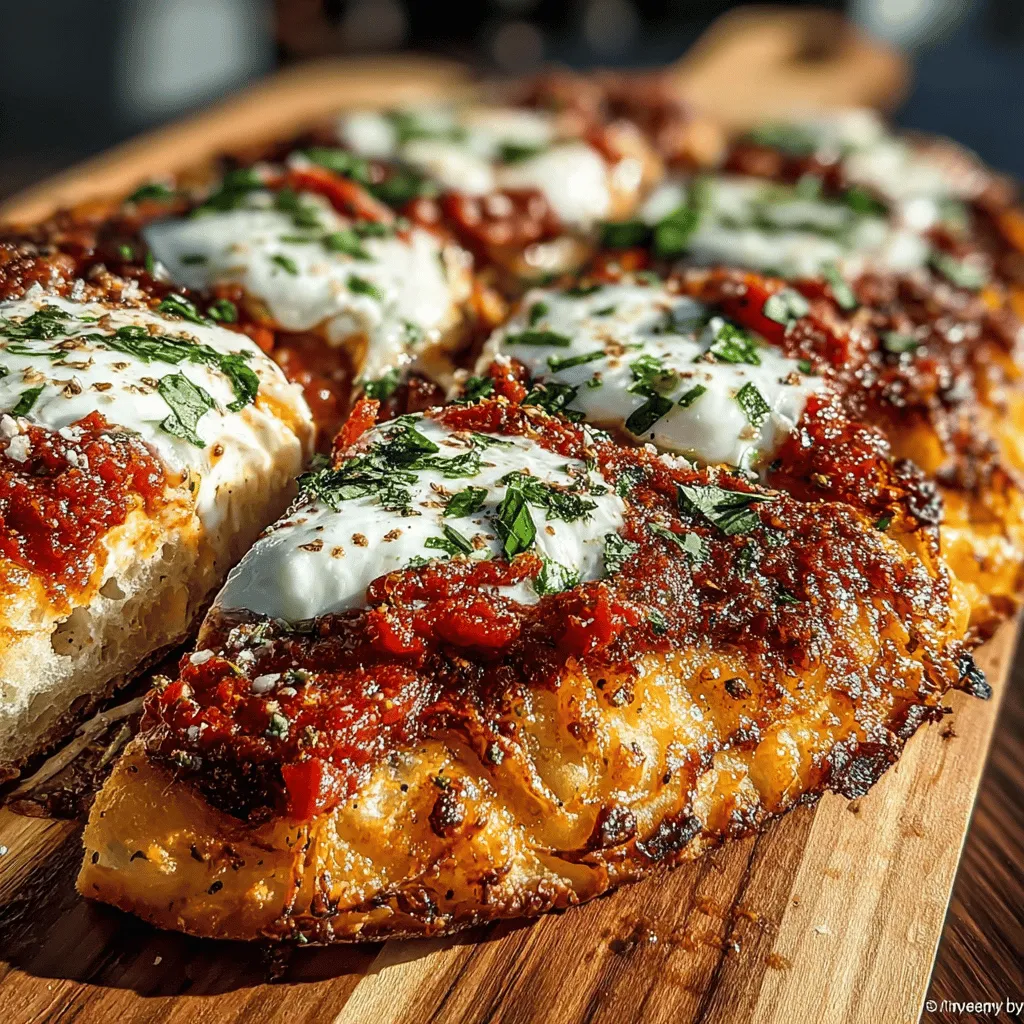Introduction
When it comes to Italian cuisine, few dishes evoke as much passion and reverence as Neapolitan pizza. Originating from Naples, this iconic dish is not merely a meal; it embodies the rich culinary traditions and cultural heritage of Italy. Neapolitan pizza is celebrated for its simplicity, yet it offers a burst of flavors that can only be achieved through high-quality ingredients and time-honored techniques. What sets this pizza apart is its unique dough, fresh toppings, and the traditional cooking method that involves high temperatures in a wood-fired oven.
In this article, we invite you to explore an authentic recipe for Classic Neapolitan Pizza. Whether you’re a seasoned chef or a cooking novice, this guide will take you through the essential steps to create a pizza that captures the essence of Naples, right in your own kitchen.
The Art of Neapolitan Pizza
Historical Background of Neapolitan Pizza
The journey of Neapolitan pizza begins in the early 18th century, when it was first created by the bakers of Naples. Initially a street food for the working class, pizza quickly gained popularity among locals and tourists alike. The Margherita pizza, named after Queen Margherita of Savoy, is one of the most famous versions, featuring tomatoes, mozzarella, and basil—symbolizing the colors of the Italian flag. Over the years, Neapolitan pizza has evolved, but its fundamental characteristics have remained intact.
Key Characteristics of a Classic Neapolitan Pizza
A classic Neapolitan pizza is defined by its thin, soft, and pliable crust, which is slightly charred and has a chewy texture. The toppings are minimal yet flavorful, typically consisting of San Marzano tomatoes, fresh mozzarella cheese, fresh basil, and a drizzle of extra virgin olive oil. The cooking method is crucial; Neapolitan pizza is baked in a wood-fired oven at temperatures exceeding 900°F (approximately 480°C), allowing the pizza to cook quickly while achieving a delightful crust and perfectly melted cheese.
Importance of Using High-Quality Ingredients
The hallmark of a great Neapolitan pizza lies in the quality of its ingredients. Each component plays a vital role in the overall flavor and experience. Authenticity is key; for instance, the tomatoes should be San Marzano, known for their sweetness and low acidity, while the mozzarella should ideally be made from buffalo milk. Using high-quality extra virgin olive oil and fresh basil elevates the pizza, contributing to the authentic taste that has made Neapolitan pizza a global favorite.
Essential Ingredients for the Perfect Dough
Creating the perfect dough is fundamental to achieving an authentic Neapolitan pizza. The ingredients you choose will significantly affect the texture and flavor of the crust. The primary components of the dough include flour, water, yeast, salt, and olive oil.
Overview of the Role of Each Ingredient in the Dough
1. Flour: The backbone of the dough. The type of flour used can drastically alter the texture and elasticity of the crust. For Neapolitan pizza, “00” flour is preferred due to its fine grind and high protein content, which yields a dough that is both elastic and easy to stretch.
2. Water: Essential for hydrating the flour and activating the yeast. The temperature of the water can influence the fermentation process.
3. Yeast: This ingredient is crucial for leavening the dough, allowing it to rise and develop flavor. Fresh yeast or active dry yeast can be used, but it’s important to ensure it’s properly activated before use.
4. Salt: Not only enhances flavor but also strengthens the gluten structure, contributing to the dough’s texture.
5. Olive Oil: While not always included in traditional recipes, a small amount can improve the dough’s elasticity and add a subtle richness to the crust.
Importance of Flour Type (All-Purpose vs. 00 Flour)
While all-purpose flour can be used in a pinch, 00 flour is the gold standard for Neapolitan pizza dough. Its lower gluten content makes it easier to stretch and shape, resulting in a light and airy crust that is characteristic of authentic Neapolitan pizza. The fine texture also aids in achieving that desirable char when baked at high temperatures.
Significance of Water Temperature and Yeast Activation
The temperature of the water you use can affect the yeast’s performance. Ideally, the water should be lukewarm (around 100°F or 38°C) to activate the yeast without killing it. If using active dry yeast, it’s essential to dissolve it in the water first and let it sit for a few minutes until it becomes frothy, indicating it’s ready to work its magic on the dough.
The Impact of Salt and Sugar on Flavor and Fermentation
Salt serves multiple purposes in dough-making. Beyond flavor enhancement, it regulates yeast activity, slowing down fermentation and thus allowing for better flavor development. While sugar is not traditionally used in Neapolitan pizza dough, a hint can help with browning, especially if you prefer a crust with a slightly caramelized finish.
Role of Olive Oil in the Dough’s Texture
Adding a dash of olive oil to the dough can help create a more tender crust. It coats the flour particles and can aid in gluten development, providing a softer texture that still has the essential chewiness characteristic of a Neapolitan pizza crust.
Crafting the Dough: From Mixing to Kneading
Now that we’ve covered the essential ingredients, it’s time to delve into the process of crafting the perfect Neapolitan pizza dough. Follow these step-by-step instructions to achieve a dough that will serve as the foundation for your pizza masterpiece.
Step-by-Step Guide to Preparing the Dough
1. Mixing Ingredients: In a large mixing bowl, combine 500 grams of 00 flour with 325 milliliters of lukewarm water. Add 10 grams of salt and 2 grams of active dry yeast. Use a wooden spoon or your hands to mix until the ingredients begin to come together.
2. Kneading the Dough: Once the dough starts to form, transfer it to a lightly floured surface. Knead the dough for about 10 minutes, or until it becomes smooth and elastic. A well-kneaded dough should spring back when pressed, indicating that the gluten has developed properly.
3. First Rise: Shape the dough into a ball and place it in a lightly oiled bowl, covering it with a damp cloth or plastic wrap. Let it rise in a warm, draft-free area for about 2 hours, or until it has doubled in size. This first rise is essential, as it allows the dough to develop flavor and texture.
Tips for Achieving the Right Dough Consistency and Texture
– Hydration Level: Be mindful of the water-to-flour ratio. A dough that is too wet will be sticky and hard to handle, while a dry dough will lack elasticity. Adjust the water slightly if necessary, but avoid adding too much flour during kneading.
– Kneading Technique: Use the heel of your hand to push the dough away from you, then fold it over itself. Rotate it and repeat. This technique helps develop gluten effectively.
Importance of Kneading and Gluten Development
Kneading is vital for creating the structure of the dough. The process aligns gluten strands, which provides strength and elasticity. Proper gluten development allows the dough to rise effectively and maintain its shape during baking, resulting in a crust that is both chewy and tender.
Explanation of the First Rise and Its Effect on Flavor and Texture
The first rise, or fermentation, is a crucial step in the dough-making process. During this time, the yeast consumes sugars and produces carbon dioxide, which causes the dough to rise. This not only gives the dough its structure but also contributes to its flavor profile. Allowing the dough to rise for an extended period can enhance its complexity, leading to a richer, more flavorful crust.
—
In this first part of our guide, we’ve explored the rich history and essential characteristics of Classic Neapolitan Pizza, as well as the fundamental ingredients and techniques for crafting the perfect dough. By understanding these foundational aspects, you are well on your way to creating an authentic Neapolitan pizza that pays homage to its roots in Naples. In the next part, we will delve into making the perfect tomato sauce, ensuring that every element of your pizza is as authentic as it can be. Stay tuned as we continue this delicious journey into Italian culinary tradition.

The Balance Between Sauce and Cheese for Optimal Flavor
When crafting the perfect Neapolitan pizza, achieving the right balance between sauce and cheese is crucial. The sauce should be vibrant, fresh, and tangy, while the cheese needs to be creamy, rich, and melt beautifully. This harmony is essential for a well-rounded flavor that does justice to this iconic Italian dish.
Choosing the Right Cheese and Fresh Ingredients
Overview of Mozzarella Types
Mozzarella is the star cheese of Neapolitan pizza, and selecting the right type can greatly influence the flavor and texture of your pizza. Here are two primary mozzarella varieties to consider:
– Fresh Mozzarella: Often sold in balls submerged in water, fresh mozzarella is soft and has a high moisture content. This cheese provides a delightful creaminess and a milky flavor, making it the traditional choice for Neapolitan pizza. It’s important to slice it thinly or tear it into smaller pieces to avoid excess water pooling on the pizza, which can lead to a soggy crust.
– Low-Moisture Mozzarella: This version is drier and has been aged longer, resulting in a firmer texture and a more concentrated flavor. While it’s commonly used in many types of pizza, it’s less authentic for Neapolitan styles. However, it can be an option if you prefer a more robust cheese taste or if fresh mozzarella is unavailable.
Importance of Using Fresh Basil and Its Flavor Profile
Fresh basil is not just a garnish; it’s an integral part of the flavor profile of Neapolitan pizza. Its aromatic oils and slightly peppery flavor enhance the overall experience of the pizza, complementing the sweetness of the tomato sauce and the creaminess of the cheese. For the best results, add whole leaves of fresh basil during the last few minutes of baking. This method allows the basil to wilt slightly while retaining its vibrant flavor and freshness.
Discussion of Optional Toppings and Their Impact on Authenticity
While the classic Neapolitan pizza is simple, featuring just tomato sauce, mozzarella, and fresh basil, there are optional toppings that can add depth without compromising authenticity. These include:
– Prosciutto: Thinly sliced and added after baking, prosciutto contributes a savory richness.
– Arugula: A handful of fresh arugula can be piled on top after baking for a peppery kick.
– Olives: A few Kalamata or black olives can add a salty note that works well with the other flavors.
Be mindful that any additional toppings should not overwhelm the pizza; the essence of Neapolitan pizza lies in its simplicity.
Assembling the Pizza: Techniques for a Beautiful Presentation
Once you have your ingredients ready, it’s time to assemble your pizza. This step is as much about technique as it is about aesthetics.
Tips for Shaping the Pizza Dough Without Losing Air
To maintain the airy structure of your dough, follow these steps:
1. Flour Your Surface: Lightly flour your work surface to prevent sticking.
2. Press, Don’t Roll: Use your fingers to gently press the dough into a disc, starting from the center and working your way outwards. Avoid using a rolling pin, as this can deflate the air bubbles that contribute to a light crust.
3. Stretching Technique: Once you’ve shaped a disc, pick it up and let gravity help you stretch it. Gently pull the edges while rotating the dough to maintain a circular shape.
Techniques for Spreading Sauce Evenly and Avoiding Soggy Crust
To prevent a soggy crust, apply your sauce judiciously:
1. Use a Spoon: Take a spoonful of sauce and dollop it in the center. Use the back of the spoon to spread it outwards in a circular motion, leaving a small rim for the crust.
2. Avoid Over-Saucing: Less is more. A thin layer of sauce allows the crust to cook properly and avoids excess moisture.
Suggestions for Arranging Cheese and Basil for Visual Appeal
For a visually stunning pizza, arrange your mozzarella and basil thoughtfully:
– Mozzarella Placement: Tear the mozzarella into pieces and distribute them evenly across the pizza. This ensures that every slice has a bit of cheese.
– Basil Arrangement: If you’re adding fresh basil before baking, scatter it across the cheese. If you prefer to add it afterward, reserve some whole leaves for garnishing once the pizza is out of the oven.
Baking to Perfection: The Importance of Oven Temperature
The right oven temperature is crucial for achieving that characteristic Neapolitan pizza crust—crispy on the outside and soft on the inside.
Explanation of the Optimal Baking Temperature for Neapolitan Pizza
Neapolitan pizzas are best baked at extremely high temperatures, ideally around 800-900°F (425-480°C). This high heat allows the crust to cook quickly, resulting in a perfectly charred exterior while keeping the interior light and airy. If you have a pizza oven, that’s fantastic! If not, you can still achieve great results using a traditional oven.
Discussion of Pizza Stones vs. Baking Sheets and Their Effects on Crust
Using a pizza stone can significantly enhance your baking:
– Pizza Stone: A pizza stone retains and radiates heat effectively, which helps achieve that crispy crust. Preheat the stone in your oven for at least 30 minutes before baking.
– Baking Sheet: If using a baking sheet, turn it upside down and preheat it in the oven. This method also helps mimic the effect of a pizza stone.
Visual Cues for Determining When the Pizza Is Done
Keep an eye on these visual cues:
– Crust Color: The crust should be golden brown and slightly charred.
– Bubbling Cheese: The cheese should be bubbly and slightly caramelized.
– Fresh Basil: If you added basil before baking, it should appear wilted and aromatic.
Finishing Touches: Enhancing Flavor and Presentation
After your pizza comes out of the oven, it’s time for some finishing touches that elevate both flavor and presentation.
Importance of Fresh Basil and Olive Oil Post-Baking
Adding fresh basil after baking enhances the pizza’s aroma and flavor. Drizzle a bit of high-quality extra virgin olive oil over the top for richness. This addition can make a significant difference, adding a layer of complexity to your pizza.
Options for Seasoning the Finished Pizza for Added Flavor
Consider these seasoning options to elevate your pizza:
– Sea Salt: A sprinkle of flaky sea salt enhances the overall flavor without overwhelming the palate.
– Red Pepper Flakes: For those who enjoy a kick, a light sprinkle of red pepper flakes adds heat and depth.
Suggestions for Serving and Enjoying Neapolitan Pizza
Slice your pizza into wedges and serve immediately. Pair it with a crisp salad or a glass of Italian wine to complement the flavors. Neapolitan pizza is best enjoyed hot and fresh, so gather your friends and family for a delightful culinary experience.
Nutritional Aspects of Neapolitan Pizza
Understanding the nutritional benefits of Neapolitan pizza can help you enjoy it as part of a balanced diet.
Overview of Nutritional Benefits of the Ingredients Used
– Tomatoes: Rich in vitamins C and A, tomatoes also contain antioxidants like lycopene, which may promote heart health.
– Mozzarella: This cheese is a good source of protein and calcium, contributing to bone health.
– Basil: Fresh basil is packed with vitamins K and A and has anti-inflammatory properties.
Discussion on Portion Control and Enjoying Pizza as Part of a Balanced Diet
While pizza can be indulgent, moderation is key. Enjoying a few slices alongside a side of vegetables or a salad can help you maintain balance in your diet. Homemade pizza allows you to control the ingredients and portion sizes, making it a healthier choice compared to fast-food options.
Conclusion
Creating an authentic Neapolitan pizza is a labor of love that pays off with every delicious bite. From the careful selection of ingredients to the techniques used in shaping and baking, every step contributes to a culinary experience that transports you to Italy. As you gather around the table to share your homemade pizza with family and friends, you’ll not only enjoy a meal but also the joy that comes from creating something special together.
We encourage you to try this classic recipe at home. Embrace the simplicity and authenticity that defines Neapolitan pizza. With practice, you can master the art of pizza-making, bringing a taste of Italy into your kitchen. Enjoy the process, savor the flavors, and most importantly, share the joy of homemade pizza with those you love.


